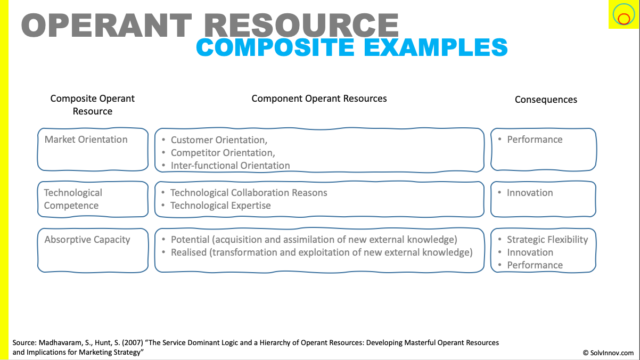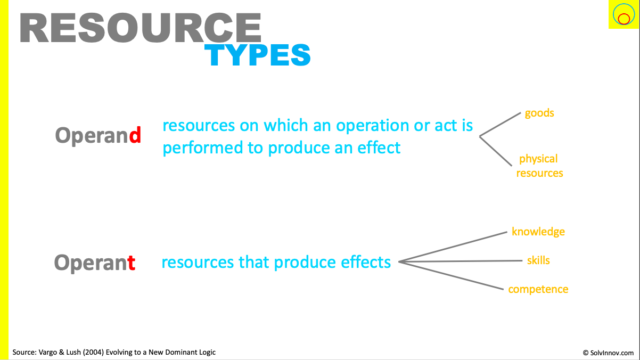The Big Picture…
I’m sure you are familiar with the following Steve Jobs’ quote?
It doesn’t make sense to hire smart people and tell them what to do; we hire smart people so they can tell us what to do.
And we precisely see people as the source of strategic benefit in service-dominant logic. They can customise value propositions, improve co-creation and can attempt value co-recovery when co-destruction emerges. Whereas in our old goods-dominant logic we would see operand resources – goods, physical resources etc – as the source.
More generally, we see operant resources – those that apply knowledge and skills on other resources – as the fundamental source of strategic benefit. Where processes – the codification of skills and competence – and technology are also operant resources.

We find there is a hierarchy of operant resources. Starting with basic operant resources (BOR) – such as our people (and also AI). Then there are composite (COR) and interconnected (IOR) operant resources.
Implications
Going up the hierarchy of operant resources becomes harder to develop and acquire. But gives us greater strategic benefit.
We need to see the beneficiary as an operant resource too (it could be suggested they are partial employees (Bitner et al (1997)). And we need to use them correctly (and/or train them) so as to ensure co-creation rather than co-destruction of value.
It’s no wonder hosts of CEOs see their people and processes as strategic benefit. And sad for those that hope their goods are.
The Idea
Does your strategic advantage come from the products you produce or the people that produce them? Traditional thinking would say it is the products. Better products (goods/service) – the output – give the advantage.
However, leaders of service-oriented organisations, are often quoted as saying their people are their advantage.
Clients do not come first, employees come first. If you take care of employees, they will take care of the clients
Richard Branson
We built Starbucks brand first with our people, not with consumers. Because we believed the best way to meet and exceed the expectations of our customers was to hire and train great people, we invested in our employees
Howard Schultz
But is it true for goods-oriented companies? Well, Steve Jobs was very clear:
It doesn’t make sense to hire smart people and tell them what to do; we hire smart people so they can tell us what to do
Steve Jobs
Apple’s people created iPad, iPhone, Apple Watch, iTunes etc. As well as more service-oriented offerings such as iCloud, Apple Music, Apple Fitness etc.
Apple’s view is not surprising. Recall that, in service-dominant logic, we see goods as simply freezing a service (the application of skills and competence) for distribution.
What we find is there are two types of resources. And one of them leads to strategic benefit. Let’s look at these resource types
There are two types of Resources
We see two types of resources: operand and operant. And it was Constantin & Lush who introduced these terms in their 1994 book “Understanding Resource Management: How to Deploy Your People, Products and Processes for Maximum Productivity“.
We’ll come to the definitions shortly. But first, look at this simple maths equation:
Here, the numbers – 1,2 and 3 – don’t do much on their own. It’s not that they have no value. They represent some notion of size and have a meaning. But what offers the real value are the operators, the addition (+) and the equals (=). They act on the numbers to do something.
And that’s really the difference between operand and operant resources. So now we can look at these in a little more detail.
Operand resources
The Tesla Model 3 is TopGear‘s number 1 electric car. And, Apple’s MacBook Pro 13 inch is PC Mag‘s editor’s choice in the ultra-portable category. Whereas The Ski Girl touts Rossignol as having the best cross country skis for 2020 across several categories.
operand resources – resources that require an action to be performed on them to lead to value co-creation
In goods-dominant thinking all these examples have embedded value. These are goods – or what we will now call operand resources.
We need to perform an action on operand resources in order to lead to value.
As such, these operand resources are usually static and tangible. That really means we are thinking of goods, natural resources, those outputs of production, etc.
But there is the second type of resources: operant.
Operant Resources
As well as access to static, tangible, resources (operand) we have access to resources that act upon other resources. These are operant resources.
operant resources – resources that act upon other (operant and/or operand) resources to lead to value co-creation
These operand resources have skills and competences. And they apply those skills and resources to other operand and/or operant resources to deliver the service.
I think the most obvious type of operant resources are your organisation’s people.
But there is a wider set of such resources. Operant resources are typically (Hunt 2004):
- “human (e.g. the skills and knowledge of individual employees)
- organizational (e.g. controls, routines, cultures, and competences)
- informational (e.g. knowledge about market segments, competitors, and technology)
- relational (e.g. relationships with competitors, suppliers, and customers)”
Operant resources are the fundamental source of strategic benefit
In goods-dominant logic we see goods as being the strategic advantage. The better car, the better icecream, the better washing machine etc. The focus goes back to maximising embedded value and exchanging it at the point of sale.
However, in service-dominant logic, we look at things differently. First we start with a service-first view point. And service is the application of skills and competencies (for the benefit of a party). Therefore the better the skills and competencies, the greater the value that can be proposed and realised (through co-creation).
And we know that the value proposed can most likely be improved by customisation. Something that an operant resource can’t do – it requires an operand resource. Further, if value co-destruction starts to occur, then only the dynamic operand resources can attempt value co-recovery.
By definition then, we need can only see operant resources as being a fundamental source of strategic benefit.
Even in a company that sees itself as a pure goods company (producing operand resources), their operant resources are the strategic benefit. Poor workmen (poor skills and competencies) with poor process/controls etc (codified skills and competencies) produce poor outputs (frozen service).
And since service is a joint activity where value is co-created during use
Why strategic benefit not strategic advantage?
Vargo & Lush (2016) made the choice to use the phrase “strategic benefit” rather than “advantage”. They did so to emphasise the service-service nature of our world. And to move competitiveness to a secondary motivator, in favour of the co-creation of value is primary. As they say:
…the realization that there is competition in the process of one actor benefiting itself through service provision to other actors, while critical, is not primary. It also points the service provider in the wrong direction, toward the competitor and thus away from the potential service beneficiary.
And it turns out, we can observe a hierarchy of operant resourcesWhen we look deeper, there starts to form a hierarchy of operant resources.
A Hierarchy of Operant Resources
Madhavaram and Hunt (2008) identified the hierarchy of operant resources you can see in Figure 2 – basic, composite and interconnected.
Firstly, basic operant resources (BOR) are those that an enterprise can readily get its hands on. The type of resources that allow it to efficiently and effectively operate. They are easily acquired, easily measured. But they are not great at sustaining a competitive advantage on their own.
Next up in the hierarchy are the composite operant resources (CORs).

And as you might imagine, these are operant resources that combine other operant resources (basic, composite or interconnected). You can see three examples, from the 13 the paper’s authors identify in Figure 3. So, for example, the COR of Market Orientation combines three operant resources of customer, competitor and inter-function orientation. The authors also have a second market orientation COR, not shown above, that combines intelligence generation, dissemination,and organisation-wide responsiveness (which aligns better to a well known defintion of market orientation)
Since these CORs are more complex they are seen as harder to obtain and/or develop. And require a bit more commitment from the enterprise. But the would be expected to result in more sustained competitive benefit.
And finally, there are the Interconnected operant resources (IORs). Two examples, from the 7 identified are in Figure 4.
As you go up the hierarchy it becomes harder to acquire and develop the operant resource. But you also gain increasing levels of sustainability and strategic benefit.
These IORs are the most complex. And fittingly they are the hardest ti acquire/develop, hardest to measure. But give the greatest strategic benefit.
Which loops us back now to the foundational premises of service-dominant logic: operant resources are the fundamental source of strategic benefit.
There’s one last thing not to forget – the beneficiary also has operant resources.
The Beneficiary has Operant Resources too
Let’s not forget that the beneficiary of the service also is and has operant resources.
For example, in an Agile software development service, the IT team is providing development skills and competencies. And the business is providing product owner skills (to prioritise which functionality is most important to develop). If the beneficiary operant resources are poor, then value co-creation will be difficult to achieve.
It has even been thought that the customer becomes a temporary employee of the service provider during the service provision. Although I would say that is a little opposite to what we want to think, i.e. the beneficiary is hiring the service. And so the service provider becomes an employee with the beneficiary. Yet, both emphasise that service provision is usually a joint effort.
Alves, Ferriera and Fernandes (2016) highlight previous studies that identify “Operant resources held by each individual may be:
- physical – include sensory-motor endowment, energy, emotions and strength.
- social – made up of both personal and cultural relationships
- cultural – include specialised knowledge and skills, life expectancy and historic imagination.”
Beneficiary operant resources and value co-creation
Interestingly, Alves, Ferreira and Fernandes (2016) also looked at customer operant resources in the context of the perceived benefit of co-creation. Figure 5 shows the set up they considered.
And they found high correlations in all of their study’s hypotheses:
- The higher the customer self-efficacy levels the higher the level of his co-creation activities
- Customers’ levels of bridging social capital positively enhance customer’s self-efficacy levels and therefore indirectly customer’s levels of co-creation activities.
- The greater the company effort in educating the customer, the greater the co-creation of value undertaken by the customer.
- The greater the company effort in educating the customer, the greater the customer expertise.
- The greater the level of customer expertise, the greater the co-creation of value undertaken.
- The greater the level of customer expertise, the greater the co-creation of value undertaken through self-efficacy perception enhancement
- The greater the level of customer co-creation activities, the greater the level of customer perceived benefits
One thing we can take away from their results is that educating the customer’s operant resources increases the potential for co-creation of value.
Wrapping Up
Of the two types of resources – operand and operant – it is clear from a service-dominant logic lens that operand resources are source of strategic benefit. These resources apply skills and competencies to other operand and operant resources in the co-creation of value.
Typically operand resources are goods. And operant resources are thought of as people. Though they can be codifications of skills and competencies. For example in controls, routines and processes. These operant resources are also wider, such as market orientation, alliance competence, entrepreneurial proclivity and more. And they exist in a hierarchy of basic, composite and interconnected resources. Where going up the hierarchy is harder to develop. Yet gives a better strategic benefit.
Finally, it is important to realise that, as service is the integration of resources, we need to pay attention to the beneficiaries operant resources. Sometimes, training the beneficiaries operant resources can improve the potential for co-creation of value.



